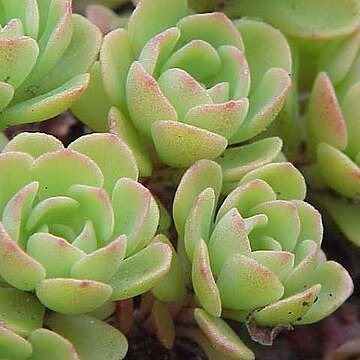Herbs, perennial, cespitose, glabrous. Stems creeping, much-branched, forming terminal rosettes on branches (primary rosettes usually 1-2.7 cm diam.). Leaves alternate, spreading to ascending, petiolate; blade pale green or blue-green, usually glaucous, oblanceolate to spatulate, laminar, (6-)10-18 × 1-4.5 mm, base petiolelike, with simple, short spur, not scarious, apex obtuse, (surfaces papillose). Flowering shoots erect, simple, 3.5-17.5 cm; leaf blades narrowly oblong to linear, base short-spurred; offsets not formed. Inflorescences cymes, 5-30-flowered, 3-branched; branches erect or only slightly recurved, sometimes forked; bracts similar to leaves, smaller. Pedicels absent. Flowers 4-merous; sepals divergent, distinct, green, linear-lanceolate, unequal, 3.6-6.3 × 0.9-1.6 mm, apex obtuse, (papillose); petals spreading, distinct, white, lanceolate, minutely hooded, 4-9 mm, apex acuminate; filaments white; anthers dark red to almost purple; nectar scales white, subquadrate. Carpels widely divergent in fruit, slightly connate basally, brown. 2n = 28, 44, 45-49.
More
Fibrous-rooted perennial, the stems tufted, spreading or prostrate, branched, with more erect flowering shoots to 1 dm; lvs blue-green or pale green, alternate, entire, somewhat flattened (generally at least twice as wide as thick), oblanceolate to spatulate, narrowed to a petiole-like base, or linear upwards, with a short, truncate basal spur, divergent, becoming recurved; infl of 2–4 short, widely divergent or recurved, secund, sympodial cymes; fls mostly 4(5)-merous; pet white, widely spreading, 5–8 mm; filaments only very shortly adnate to the pet; frs divaricate; 2n=28, less often 44, 56. Rocky places, mainly in the mts.; Md., Va., W.Va., and nw. N.C. Apr.–June. Closely allied to S. nevii A. Gray, which has thicker lvs, more closely striate seeds, and 2n=12, and is confined to the s. end of the s. Appalachian Mts., beyond our range.

